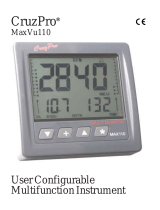
Split-Zoom Sonar View........................................................ 15
Garmin ClearVü Sonar View.....................................................15
SideVü Sonar View................................................................... 16
SideVü Scanning Technology.............................................. 16
Panoptix Sonar Views...............................................................16
LiveVü Down Sonar View.................................................... 16
LiveVü Forward Sonar View................................................ 16
RealVü 3D Forward Sonar View.......................................... 16
RealVü 3D Down Sonar View.............................................. 17
RealVü 3D Historical Sonar View........................................ 17
FrontVü Sonar View............................................................. 17
Selecting the Transducer Type................................................. 17
Calibrating the Compass......................................................17
Creating a Waypoint on the Sonar Screen............................... 17
Pausing the Sonar Display....................................................... 17
Viewing Sonar History.............................................................. 17
Sonar Sharing........................................................................... 17
Selecting a Sonar Source.................................................... 18
Renaming a Sonar Source...................................................18
Adjusting the Level of Detail..................................................... 18
Adjusting the Color Intensity..................................................... 18
Sonar Recordings..................................................................... 18
Recording the Sonar Display............................................... 18
Stopping the Sonar Recording............................................. 18
Deleting a Sonar Recording................................................. 18
Playing Sonar Recordings................................................... 18
Traditional, Garmin ClearVü, and SideVü Sonar Setup........... 18
Setting the Zoom Level on the Sonar Screen...................... 19
Setting the Scroll Speed...................................................... 19
Adjusting the Range of the Depth or Width Scale............... 19
Sonar Appearance Settings................................................. 19
Sonar Alarms....................................................................... 19
Advanced Sonar Settings.................................................... 19
Transducer Installation Settings...........................................20
Sonar Frequencies...............................................................20
Turning On the A-Scope...................................................... 20
Panoptix Sonar Setup............................................................... 20
Adjusting the RealVü Viewing Angle and Zoom Level......... 20
Adjusting the RealVü Sweep Speed.................................... 20
LiveVü Forward and FrontVü Sonar Menu.......................... 20
LiveVü and FrontVü Appearance Settings........................... 21
RealVü Appearance Settings............................................... 21
Panoptix Transducer Installation Settings........................... 21
Autopilot........................................................................ 22
Autopilot Screen....................................................................... 22
Adjusting the Step Steering Increment................................ 22
Setting the Power Saver...................................................... 22
Engaging the Autopilot............................................................. 22
Steering Patterns...................................................................... 22
Following the U-Turn Pattern............................................... 22
Setting Up and Following the Circles Pattern...................... 23
Setting Up and Following the Zigzag Pattern...................... 23
Following the Williamson Turn Pattern................................ 23
Sailing Features............................................................ 23
Setting the Vessel Type............................................................ 23
Sail Racing................................................................................23
Starting Line Guidance........................................................ 23
Using the Race Timer.......................................................... 23
Setting the Distance between the Bow and the GPS
Antenna................................................................................23
Laylines Settings.......................................................................23
Setting the Keel Offset.............................................................. 24
Sailboat Autopilot Operation..................................................... 24
Wind Hold............................................................................ 24
Tack and Gybe.....................................................................24
Gauges and Graphs..................................................... 25
Viewing the Compass............................................................... 25
Viewing Trip Gauges................................................................ 25
Resetting Trip Gauges......................................................... 25
Viewing Engine and Fuel Gauges............................................ 25
Selecting the Number of Engines Shown in Gauges........... 25
Customizing the Engines Shown in Gauges........................ 25
Enabling Status Alarms for Engine Gauges........................ 25
Enabling Some Engine Gauge Status Alarms..................... 25
Setting the Fuel Alarm.............................................................. 25
Setting the Fuel Capacity of the Vessel............................... 25
Synchronizing the Fuel Data with the Actual Vessel Fuel... 25
Viewing the Wind Gauges........................................................ 25
Configuring the Sailing Wind Gauge.................................... 25
Configuring the Speed Source............................................. 25
Configuring the Heading Source of the Wind Gauge........... 25
Customizing the Close-Hauled Wind Gauge....................... 26
Tide, Current, and Celestial Information.................... 26
Tide Station Information............................................................26
Current Station Information.......................................................26
Celestial Information................................................................. 26
Viewing Tide Station, Current Station, or Celestial Information
for a Different Date................................................................... 26
Viewing Information for a Different Tide or Current Station...... 26
Digital Selective Calling............................................... 26
Chartplotter and NMEA 0183 VHF Radio Functionality............ 26
Turning On DSC....................................................................... 26
DSC List....................................................................................26
Viewing the DSC List........................................................... 26
Adding a DSC Contact......................................................... 26
Incoming Distress Calls............................................................ 26
Navigating to a Vessel in Distress....................................... 26
Position Tracking...................................................................... 27
Viewing a Position Report.................................................... 27
Navigating to a Tracked Vessel........................................... 27
Creating a Waypoint at the Position of a Tracked Vessel.... 27
Editing Information in a Position Report.............................. 27
Deleting a Position-Report Call............................................ 27
Viewing Vessel Trails on the Chart...................................... 27
Individual Routine Calls............................................................ 27
Selecting a DSC Channel.................................................... 27
Making an Individual Routine Call....................................... 27
Making an Individual Routine Call to an AIS Target............ 27
Media Player................................................................. 27
Opening the Media Player........................................................ 27
Icons.................................................................................... 27
Selecting the Media Source...................................................... 28
Playing Music............................................................................28
Browsing for Music...............................................................28
Setting a Song to Repeat..................................................... 28
Setting All Songs to Repeat................................................. 28
Setting Songs to Shuffle...................................................... 28
Adjusting the Volume................................................................ 28
Enabling and Disabling Zones............................................. 28
Muting the Media Volume.................................................... 28
VHF Radio................................................................................ 28
Scanning VHF Channels......................................................28
Adjusting the VHF Squelch.................................................. 28
Radio........................................................................................ 28
Setting the Tuner Region..................................................... 28
Changing the Radio Station................................................. 28
Changing the Tuning Mode................................................. 28
Presets................................................................................. 28
DAB Playback........................................................................... 28
Setting the DAB Tuner Region............................................ 29
ii Table of Contents
























